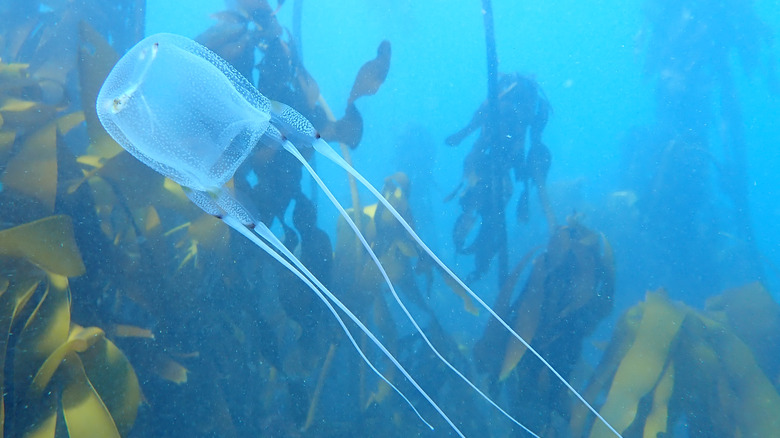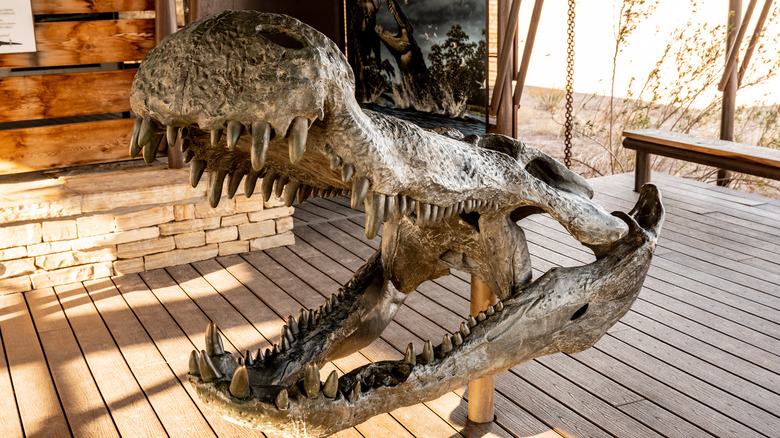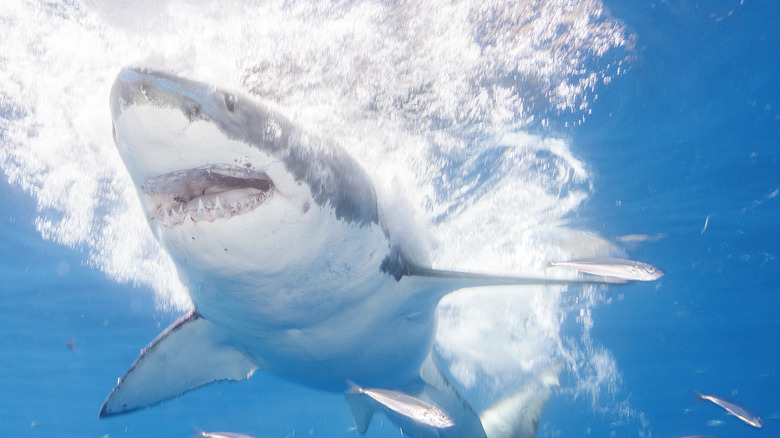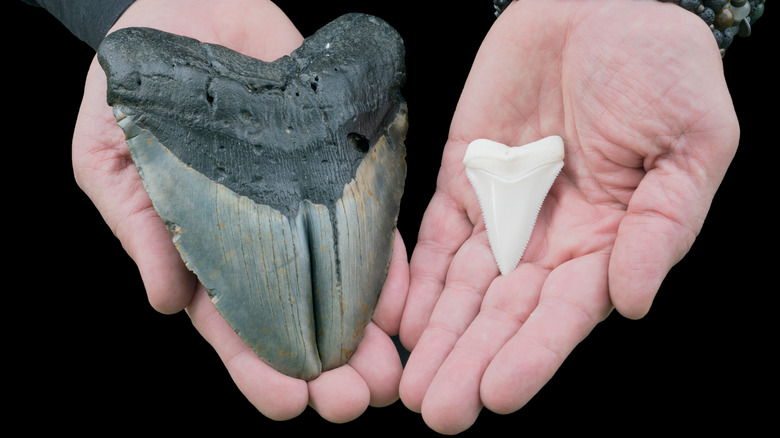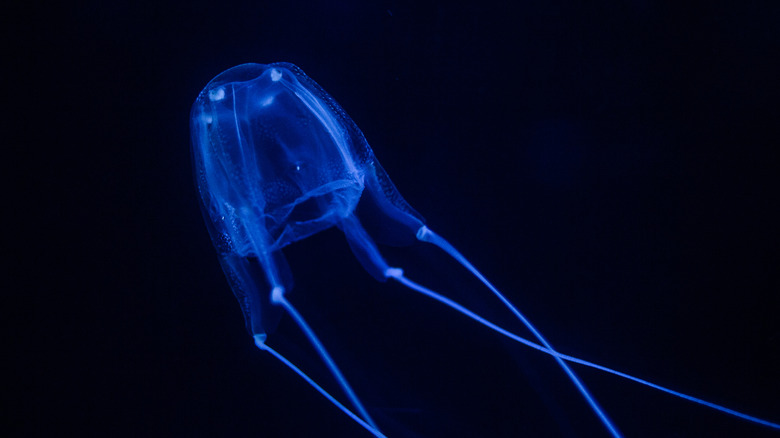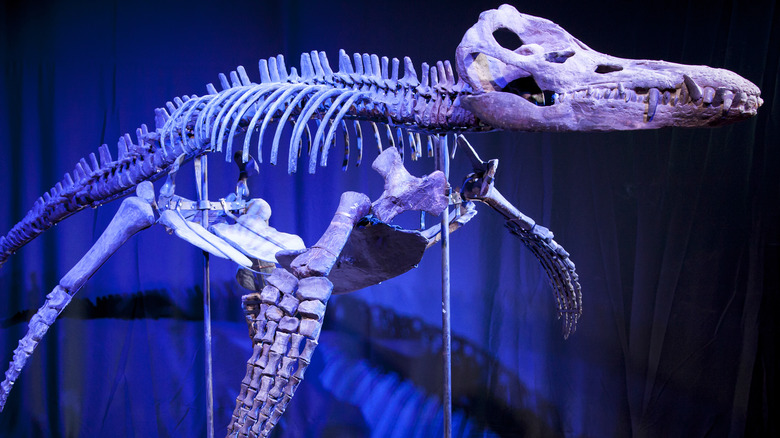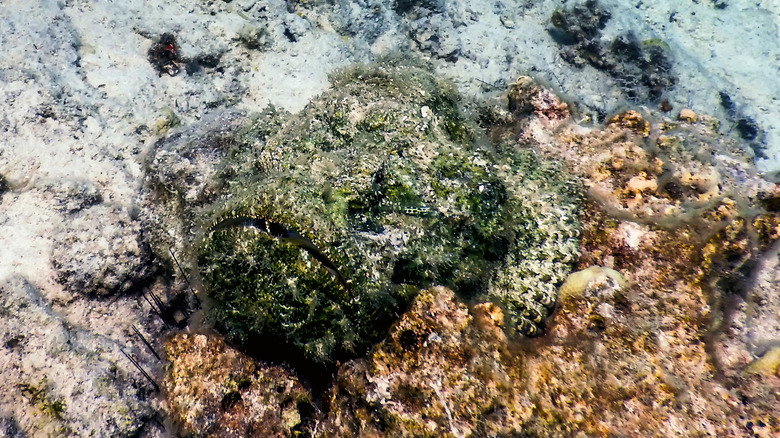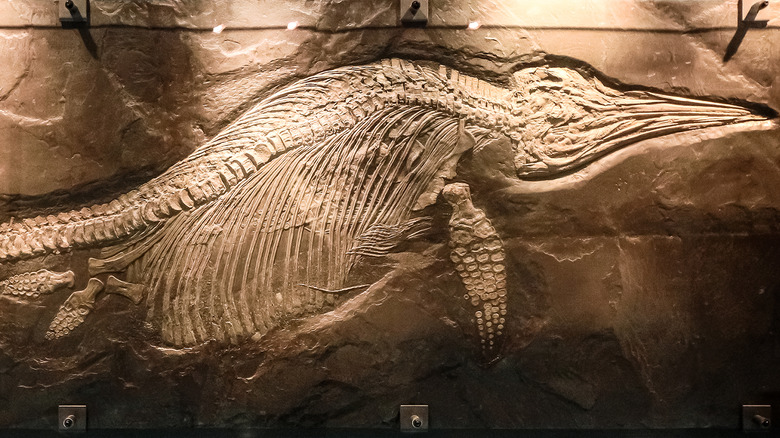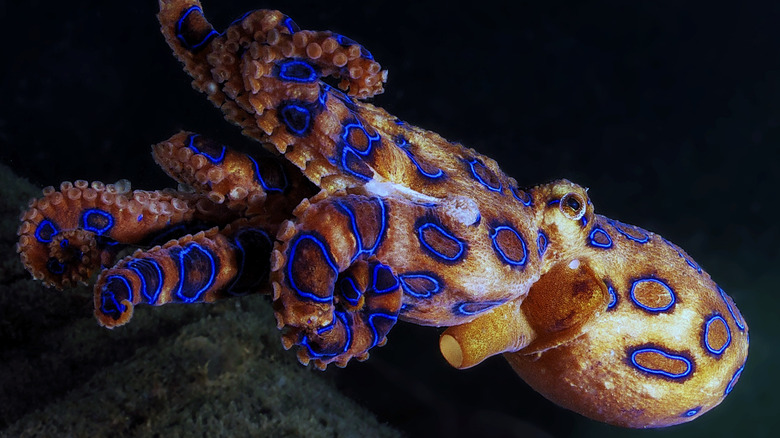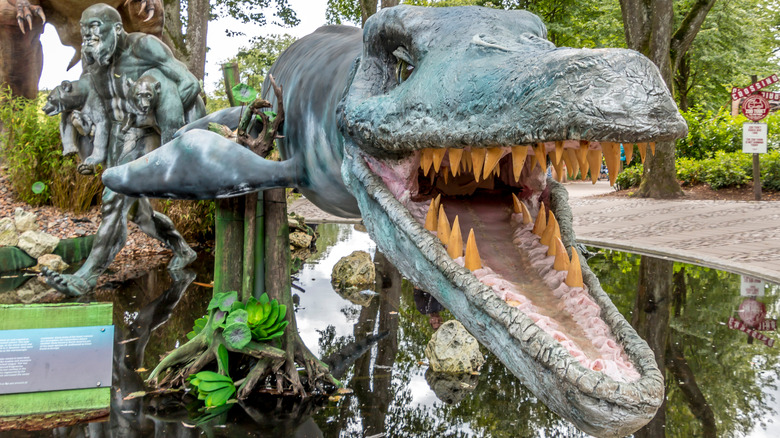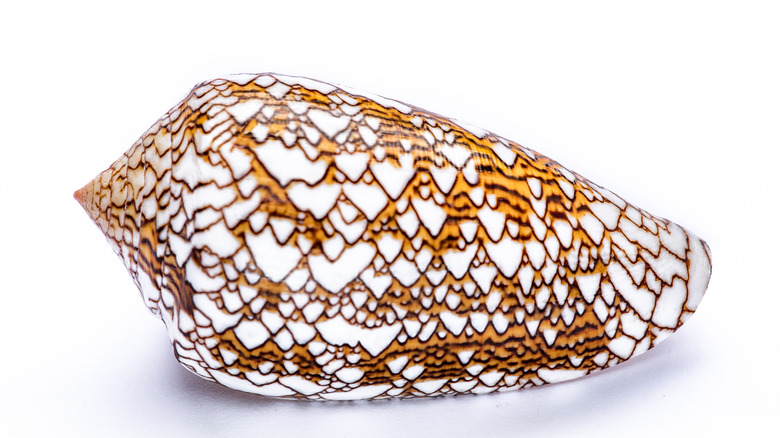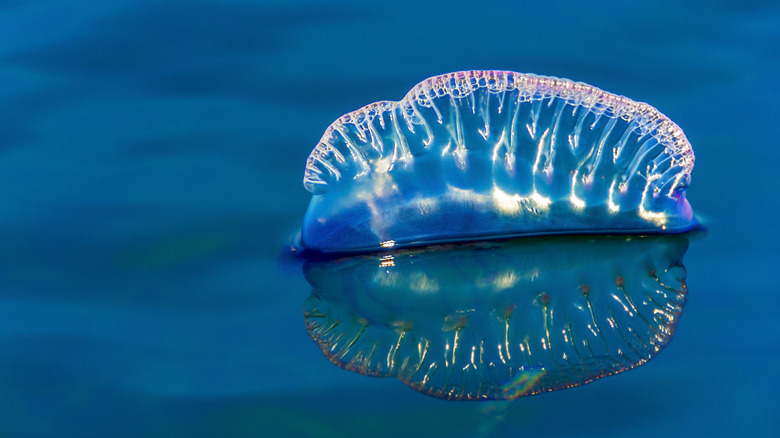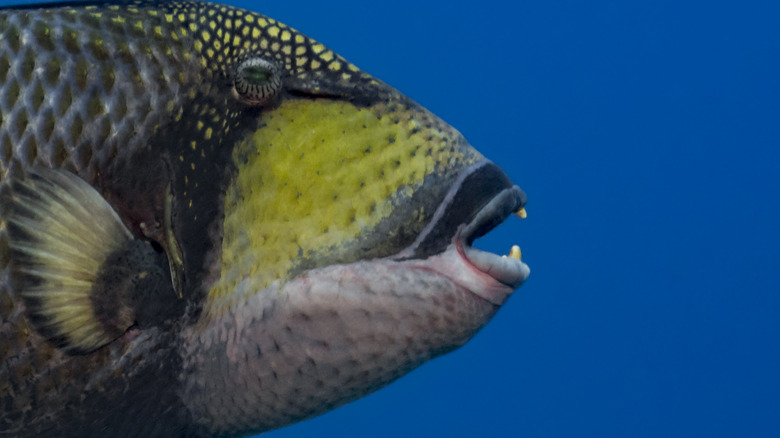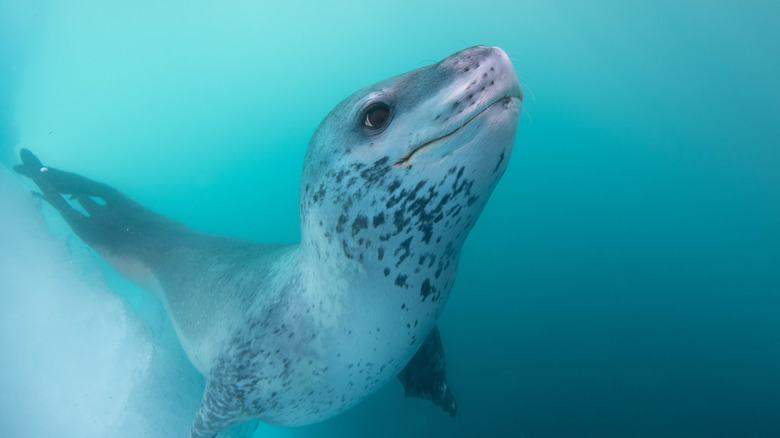Most Dangerous Sea Creatures To Ever Exist
The Earth's surface is over 70% water, but its vast oceans are still mostly a mystery to humans. In fact, the National Ocean Service states that more than 80% of the sea is unexplored. Indeed, the water has been full of fascinating creatures across history, from tiny yet extremely venomous octopuses to massive marine reptiles more than twice the size of the African bush elephant — the largest modern land animal. But the ocean has also sometimes been home to deadly animals.
Since humanity doesn't have to deal with the apex predators of the prehistoric sea, the best way to avoid being harmed by an aquatic creature is to give them their space whenever possible. The largest modern predators in the sea are sharks, but even the dreaded great white is unlikely to intentionally consume a human (though they aren't above a curious bite.) As stated by the Florida Museum, "You have a better chance of dying from a bee sting, a dog or snake bite, or lightning than from a shark attack."
While modern aquatic creatures may seem terrifying, humans are an even greater threat to them. According to the Natural History Museum, "nature is stretching to the breaking point" due to "overfishing, pollution, and climate change." Some even believe that by the year 2050, there may be more plastic in the ocean than fish. Still, it's undeniable that the waters of Earth contain some dangerous species. Without further ado, here are the most dangerous creatures to ever swim the seas.
Deinosuchus hatcheri
According to the BBC, modern crocodiles kill about a thousand people every year worldwide (alligators kill less than 10 per decade.) While they are impressive predators, they are nothing compared to Deinosuchus hatcheri — massive prehistoric alligators that had teeth the size of bananas.
Eight million years ago, these ancient reptiles were not hunting birds or fish like their modern equivalents. Instead, they opted for larger prey. This is not surprising considering they were 30-35 feet long and weighed a whopping 8,000 pounds — approximately 10 times more than a modern alligator. These creatures also had a varied and impressive diet. According to The New York Times, evidence has revealed Deinosuchus hatcheri bite marks on turtle shells and even dinosaur bones. It is believed that they hunted by ambushing their prey like modern crocodilians. If an unlucky dinosaur came to drink at the water's edge, they might end up as food for this "terror crocodile."
Interestingly there is evidence that there were two holes at the tip of the ancient crocodile's enlarged snout in front of its nose. This has led to some depicting the species with teeth too large to fit into their massive jaws.
Sharks
According to an article published in The Journal of Trauma and Acute Care Surgery, there are an average of 50 shark attacks across the world per year, with the vast majority only resulting in minor injuries. Despite this, they remain prominent figures in the public consciousness and are likely the most feared creature in the sea.
As noted by Richard Pallardy's article in Britannica, it is believed that the "erratic motion of humans and the contrast between their skin and their attire can confuse sharks" that are hunting for schools of fish. It's believed that great whites, bull sharks, and tiger sharks that "attack" people are typically trying to figure out what humans in the water are. "Their mouths also function as finely tuned sensory organs," Pallardy wrote, so they investigate new items and creatures the only way they know how: an exploratory bite.
Some sharks are also territorial, at least around other sharks. Bigger, stronger sharks hunt in the best spots for catching prey and are known to force out smaller sharks. Some believe that sharks attack humans when they feel they are encroaching on their feeding grounds. But while sharks are probably the most feared creatures in the modern ocean — despite how unlikely it is to be killed by one — they are nowhere near as much of a threat as their prehistoric counterparts.
Megalodon
If sharks are scary, then the megalodon is the ultimate terrifying sea creature. The name megalodon actually means "large tooth." Indeed, this apex predator was the largest shark to ever hunt in Earth's oceans, and their teeth were more than seven inches long; it is believed that an adult megalodon had over 270.
According to the Natural History Museum, 3.6 million years ago, megalodons were so massive that they survived on a diet of dolphins and whales. While humans never had to deal with megalodons, it is believed that they could open their mouths wide enough to "swallow two adult people side by side." Megalodons would have been hard to avoid, as their teeth have been found everywhere from the coasts of South Carolina to Morocco, England, and Australia, showing their incredible range.
Originally, megalodons were depicted as large modern sharks, but it is now believed that they looked quite different from a great white. In fact, they may only be distant cousins. Emma Bernard, the Natural History Museum's curator for fossil fish, states the megalodon is actually the last surviving member of an entirely different lineage of shark than exists today.
Box jellyfish
While it might not look very frightening, the box jellyfish may be the most deadly animal in the modern ocean. These jellyfish can be difficult for humans to avoid, as they are often transparent. They are highly evolved for their species and are actually able to direct their movement rather than just drift through the ocean with the water. They also have surprisingly good vision for a jellyfish, with clusters of six eyes in four places on their domed body. Their tentacles can be up to 10 feet long, and each is equipped with thousands of stinging cells. According to National Geographic, their venom is considered to be "among the most deadly in the world."
It is believed the box jellyfish kill tens of people every year, but not all are reported, so there might be even more. According to Healthline, symptoms of a box jellyfish sting can range from severe pain to disorientation, breathing problems, and even cardiac arrest. People who are stung may go into shock while still in the water, leading to death by drowning. One person who was stung reported the excruciating details of the experience to The Guardian, saying, "My heart was racing, and every one of my muscles tensed, then went into spasm. I was in blinding pain all over. I lost the ability to speak or think."
Liopleurodon
In the late Jurassic period, these long-jawed marine reptiles dominated the sea. Famous for appearing in "Charlie the Unicorn" and terrifying children everywhere in "Walking with Dinosaurs," this aquatic hunter may have been the largest predator ever in Earth's oceans. The BBC calls liopleurodon "the mightiest aquatic predator of all time," and this reputation is well-earned. It is believed that they were able to smell underwater, allowing them to track down their prey. Liopleurodons were likely eating everything from saltwater crocodiles to other pliosaurs with their "rows of needle-like teeth." And while they needed to breathe air to live, the liopleurodon was a purely aquatic creature, unable to live outside of the ocean.
There is great debate about the size of the liopleurodon. One fossil discovered in Mexico in 2003 indicates that it was almost 60 feet long — the height of almost two telephone poles laid end-to-end — when still a juvenile. Modern estimates, such as those reported in Forbes, place adults of the species at about 20 feet long. Regardless of the two maximum sizes of an adult liopleurodon, it still topped the predator chart in terms of size.
Stonefish
If it's hard to see the box jellyfish, avoiding the stonefish is almost impossible. These remarkable camouflaging fish sit on the seafloor, blending in perfectly with the rocks and sand. According to Oceana, sometimes these fish even grow algae on their bodies, which makes them incredibly difficult to discern from the environment. Ultimately, this camouflage helps them to ambush their prey and avoid being eaten by larger fish.
The stonefish has another secret weapon when it comes to avoiding predators, and it's the reason it has been called the "world's most venomous fish." This secret weapon is located in the fish's fin spines, which can inject enough venom to kill a human adult in less than an hour. While these fish do not go after people intentionally, they are likely to inject venom into any person who is unlucky enough to step on them by accident.
Although there are not many reported deaths per year from stonefish stings, they do require medical treatment as soon as possible and are excruciatingly painful. One person who was stung in the finger by a stonefish is quoted by Ocean Conservancy as saying the experience was like "having each knuckle then the wrist, elbow, and shoulder being hit in turn with a sledgehammer over the course of an hour."
Cymbospondylus
Cymbospondylus' were about 32 feet long, which is approximately the size of the largest killer whale ever recorded. The sleek creature had a tail like an eel and a long face like a dolphin — but full of sharp teeth. A 2006 study published in the Zoological Journal of the Linnean Society covers a species of Cymbospondylus found in Nevada and says they "were certainly positioned at the top of the food chain." In fact, it is believed that they could have been "ambush hunters" and "were capable of traveling over long distances in the search for food."
According to the BBC, the genus lived in the late Triassic era. These big aquatic carnivores hunted the oceans looking for large reptiles and ammonites, which the Natural History Museum describes as a kind of shelled cephalopod. It is believed that Cymbospondylus would have had no predators in adulthood — they were simply too large.
Blue-ringed Octopus
Like all octopuses, the blue-ringed species has three hearts and a ring-shaped brain, with its esophagus in the middle. But this species is particularly venomous compared to its counterparts. When threatened, it creates an incredible pattern of neon blue circles all over its body to scare off any potential predators. And it's not a bluff — according to Ocean Conservancy, this tiny octopus has a venom "1,000 times more powerful than cyanide" and contains enough "to kill 26 humans within minutes."
The toxin paralyzes anything unfortunate enough to be bitten. The Australian Institute of Marine Science reports that bites from this genus of octopus have been responsible for at least three human deaths. Fortunately, this shy octopus is polite enough to use its pattern to signal that it is deadly and never goes out of its way to bite people. Generally, these creatures only use their venomous bite if "they are being harassed and poked."
Mosasaur
Mosasaurs are marine reptiles of the Cretaceous period described by National Geographic as being "among the ocean's most fearsome and successful predators." These adaptable creatures are thought to have lived all across the globe, with fossil remains being found "on every continent including Antarctica." They had "long serpentine bodies," which is unsurprising as they are thought to be early relatives of snakes. Specifically, large mosasaurs — like mosasaurus and tylosaurus — could grow up to fifty feet long. These enormous apex predators devoured everything in their path, including other mosasaurs, sharks, and the large long-necked hunters called plesiosaurs.
Humans never had to share the planet with these incredible creatures, as it is believed that they went extinct along with the dinosaurs. Per Florida News Times, Mike Everhard, author of "The Sea of Kansas," stated, "The sea would not have been a safe place to swim in the Cretaceous. At that time, Mosasaurus was the best predator in the sea."
Textile cone snail
Textile cone snails have beautiful shells that can, unfortunately, prove fatal for humans. Sometimes an unsuspecting person will pick up a cone snail for a better look, only to discover that this sea creature is one of the most venomous on the planet. According to the Aquarium of the Pacific, they hunt using hollow "harpoon-like" teeth. Their toxic venom is meant for other mollusks — even other cone snails if they are starving — but humans can also get a deadly sting if they step on the snail.
According to "Cone Snail Toxicity" published in StatPearls, venom obtained from one cone snail has the potential to kill up to 700 people. Elsewhere, ABC News spotlighted a case where a barefoot human was stung by a cone snail. Although he was in stable condition after the attack, the outlet noted that such stings can have severe effects, including vision impairment, respiratory failure, and even death.
Portuguese Man O' War
The Portuguese Man O' War is a strange and beautiful "organism" that looks somewhat like a jellyfish and drifts along the ocean's surface with the current. Its iridescent, air-filled "sail" keeps it afloat as it drags stinging tentacles behind it that can grow to over 150 feet long. As explained in "Blue Planet II," these tentacles kill fish when they come in contact with them, and the creatures may capture and consume over 100 fish a day. It is unlikely that a human will be killed by the Portuguese Man O' War, but not impossible. According to "Fatal Portuguese man-o'-war (Physalia physalis) envenomation," it is possible for humans who touch this species to experience "primary respiratory arrest" followed by "cardiovascular collapse."
Fascinatingly, Oceana states that a Portuguese Man O' War is not a single animal but a colony that can only survive by working together to feed. Colonies keep themselves at the sea surface with a shared float and also possess rudimentary reproductive and digestive systems. Although they appear to casual observers to be a single creature, they are so dependent on each other that no part can survive alone.
Triggerfish
The Triggerfish is not usually among the dangers that divers are warned about, but there have been multiple accounts of these usually shy creatures becoming aggressive and injuring humans. J.E. Randall and J.T. Millington's article in the Journal of Wilderness Medicine details the little-known danger of this family of fish. Although they are generally "among the most-wary in the sea," fish who have been cornered or "females guarding a nest" may be aggressive to other fish or human divers.
Indeed, there have been reports of triggerfish chasing after people and latching onto them. And these bites can be serious, as these fish have strong jaws and sharp teeth, powerful enough to crush the mollusks, crabs, and coral they eat. While these beautiful fish can be "a real hazard to divers" and there are numerous videos of them lunging at and chasing after people, there are no known fatalities associated with the species.
Leopard seal
People often think of seals as cute furry animals, but some of them are serious hunters. In particular, the earless leopard seals don't just enjoy fish — they will also hunt fast-swimming penguins and even other seals. They can grow to be over eleven feet long, and they have extraordinarily large heads and jaws that appear almost "snake-like," per New Zealand's Department of Conservation.
Explorer Gareth Wood recounted his experience with this species in his book "South Pole, 900 Miles on Foot." The traveler explained that he was in Antarctica when he came to a large crack in the ice. After poking at it with one foot, something terrifying happened: "Suddenly, the surface erupted as the massive head and shoulders of a mature leopard seal, mouth gaping in expectation, crashed through the eggshell covering. It closed its powerful jaws about my right leg."
Thankfully, Wood survived the encounter. Attacks on humans by leopard seals are extremely rare, and there is only one known fatality. Usually, they are no threat to humans and generally only defend themselves when they "feel threatened." People are encouraged to give them space and avoid startling them.
